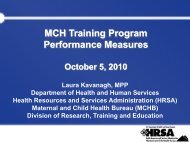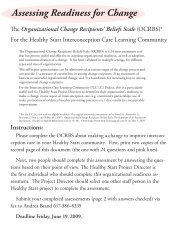MCH Training Programs: Faculty and Trainee Research on ... - HRSA
MCH Training Programs: Faculty and Trainee Research on ... - HRSA
MCH Training Programs: Faculty and Trainee Research on ... - HRSA
You also want an ePaper? Increase the reach of your titles
YUMPU automatically turns print PDFs into web optimized ePapers that Google loves.
Maternal <str<strong>on</strong>g>and</str<strong>on</strong>g> Child Health<br />
Bureau<br />
<str<strong>on</strong>g>MCH</str<strong>on</strong>g> <str<strong>on</strong>g>Training</str<strong>on</strong>g><br />
<str<strong>on</strong>g>Programs</str<strong>on</strong>g>: <str<strong>on</strong>g>Faculty</str<strong>on</strong>g> <str<strong>on</strong>g>and</str<strong>on</strong>g><br />
<str<strong>on</strong>g>Trainee</str<strong>on</strong>g> <str<strong>on</strong>g>Research</str<strong>on</strong>g> <strong>on</strong> Health<br />
Disparities <str<strong>on</strong>g>and</str<strong>on</strong>g> Cultural<br />
Competence<br />
September 16, 2003<br />
Health Resources <str<strong>on</strong>g>and</str<strong>on</strong>g> Services Administrati<strong>on</strong><br />
Maternal <str<strong>on</strong>g>and</str<strong>on</strong>g> Child Health Bureau<br />
Maternal <str<strong>on</strong>g>and</str<strong>on</strong>g> Child Health<br />
Bureau<br />
Presentati<strong>on</strong> For <str<strong>on</strong>g>Training</str<strong>on</strong>g><br />
<str<strong>on</strong>g>MCH</str<strong>on</strong>g>COM.COM<br />
September 16, 2003<br />
Health Resources And Services Administrati<strong>on</strong><br />
Maternal And Child Health Bureau<br />
Peter C. Van Dyck, MD, MPH
Maternal <str<strong>on</strong>g>and</str<strong>on</strong>g> Child Health Bureau<br />
Maternal <str<strong>on</strong>g>and</str<strong>on</strong>g> Child Health Bureau<br />
<str<strong>on</strong>g>MCH</str<strong>on</strong>g>B<br />
<str<strong>on</strong>g>MCH</str<strong>on</strong>g>B Strategic Plan Missi<strong>on</strong><br />
“To provide nati<strong>on</strong>al leadership <str<strong>on</strong>g>and</str<strong>on</strong>g> to work,<br />
in partnership with states, communities,<br />
public-private partners, <str<strong>on</strong>g>and</str<strong>on</strong>g> families to<br />
strengthen the <str<strong>on</strong>g>MCH</str<strong>on</strong>g> infrastructure, assure the<br />
availability <str<strong>on</strong>g>and</str<strong>on</strong>g> use of medical homes, <str<strong>on</strong>g>and</str<strong>on</strong>g><br />
build the knowledge <str<strong>on</strong>g>and</str<strong>on</strong>g> human resources, in<br />
order to assure c<strong>on</strong>tinued improvement in the<br />
health, safety <str<strong>on</strong>g>and</str<strong>on</strong>g> well-being of the <str<strong>on</strong>g>MCH</str<strong>on</strong>g><br />
populati<strong>on</strong>”
Maternal <str<strong>on</strong>g>and</str<strong>on</strong>g> Child Health Bureau<br />
Maternal <str<strong>on</strong>g>and</str<strong>on</strong>g> Child Health Bureau<br />
<str<strong>on</strong>g>MCH</str<strong>on</strong>g>B Strategic Plan Missi<strong>on</strong><br />
“The <str<strong>on</strong>g>MCH</str<strong>on</strong>g> populati<strong>on</strong> includes all America’s<br />
women, infants, children, adolescents <str<strong>on</strong>g>and</str<strong>on</strong>g><br />
their families, including women of<br />
reproductive age, fathers, <str<strong>on</strong>g>and</str<strong>on</strong>g> children with<br />
special health care needs(CSHCN)”<br />
<str<strong>on</strong>g>MCH</str<strong>on</strong>g>B Strategic Plan Goals<br />
Provide Nati<strong>on</strong>al Leadership for Maternal <str<strong>on</strong>g>and</str<strong>on</strong>g><br />
Child Health by creating a shared visi<strong>on</strong> <str<strong>on</strong>g>and</str<strong>on</strong>g><br />
goals for <str<strong>on</strong>g>MCH</str<strong>on</strong>g>, informing the public about<br />
<str<strong>on</strong>g>MCH</str<strong>on</strong>g> needs <str<strong>on</strong>g>and</str<strong>on</strong>g> issues, modeling new<br />
approaches to strengthen <str<strong>on</strong>g>MCH</str<strong>on</strong>g>, forging<br />
str<strong>on</strong>g collaborative partnerships, <str<strong>on</strong>g>and</str<strong>on</strong>g><br />
fostering a respectful envir<strong>on</strong>ment that<br />
supports creativity, acti<strong>on</strong>, <str<strong>on</strong>g>and</str<strong>on</strong>g> accountability<br />
for <str<strong>on</strong>g>MCH</str<strong>on</strong>g> issues.
Maternal <str<strong>on</strong>g>and</str<strong>on</strong>g> Child Health Bureau<br />
Maternal <str<strong>on</strong>g>and</str<strong>on</strong>g> Child Health Bureau<br />
<str<strong>on</strong>g>MCH</str<strong>on</strong>g>B Strategic Plan Goals<br />
Eliminate health disparities in health status<br />
outcomes, through the removal of ec<strong>on</strong>omic,<br />
social <str<strong>on</strong>g>and</str<strong>on</strong>g> cultural barriers to receiving<br />
comprehensive timely <str<strong>on</strong>g>and</str<strong>on</strong>g> appropriate health<br />
care<br />
<str<strong>on</strong>g>MCH</str<strong>on</strong>g>B Strategic Plan Goals<br />
To assure the highest quality of care through<br />
the development of practice guidance, data<br />
m<strong>on</strong>itoring, <str<strong>on</strong>g>and</str<strong>on</strong>g> evaluati<strong>on</strong> tools; the<br />
utilizati<strong>on</strong> of evidence-based research; <str<strong>on</strong>g>and</str<strong>on</strong>g><br />
the availability of a well-trained, culturally<br />
diverse workforce
Maternal <str<strong>on</strong>g>and</str<strong>on</strong>g> Child Health Bureau<br />
Maternal <str<strong>on</strong>g>and</str<strong>on</strong>g> Child Health Bureau<br />
<str<strong>on</strong>g>MCH</str<strong>on</strong>g>B Strategic Plan<br />
Goals<br />
To facilitate access to care through the<br />
development <str<strong>on</strong>g>and</str<strong>on</strong>g> improvement of the <str<strong>on</strong>g>MCH</str<strong>on</strong>g><br />
health infrastructure <str<strong>on</strong>g>and</str<strong>on</strong>g> systems of care to<br />
enhance the provisi<strong>on</strong> of the necessary<br />
coordinated, quality health care<br />
<str<strong>on</strong>g>MCH</str<strong>on</strong>g> BUREAU
Maternal <str<strong>on</strong>g>and</str<strong>on</strong>g> Child Health Bureau<br />
Maternal <str<strong>on</strong>g>and</str<strong>on</strong>g> Child Health Bureau<br />
CORE PUBLIC HEALTH SERVICES<br />
DELIVERED BY <str<strong>on</strong>g>MCH</str<strong>on</strong>g> AGENCIES<br />
DIRECT<br />
HEALTH CARE<br />
SERVICES<br />
(GAP FILLING)<br />
Examples:<br />
Basic Health Services <str<strong>on</strong>g>and</str<strong>on</strong>g><br />
Health Services for CSHCN<br />
<str<strong>on</strong>g>MCH</str<strong>on</strong>g> CHC EPSDT SCHIP<br />
ENABLING SERVICES<br />
Examples:<br />
Transportati<strong>on</strong>, Translati<strong>on</strong>, Outreach, Respite Care,<br />
Health Educati<strong>on</strong>, Family Support Services, Purchase of<br />
Health Insurance, Case Management, Coordinati<strong>on</strong> with<br />
Medicaid, WIC <str<strong>on</strong>g>and</str<strong>on</strong>g> Educati<strong>on</strong><br />
POPULATION--BASED SERVICES<br />
Examples:<br />
Newborn Screening, Lead Screening, Immunizati<strong>on</strong>, Sudden Infant Death<br />
Counseling, Oral Health, Injury Preventi<strong>on</strong>, Nutriti<strong>on</strong> <str<strong>on</strong>g>and</str<strong>on</strong>g> Outreach/Public Educati<strong>on</strong><br />
INFRASTRUCTURE BUILDING SERVICES<br />
Examples:<br />
Needs Assessment, Evaluati<strong>on</strong>, Planning, Policy Development, Coordinati<strong>on</strong>,<br />
Quality Assurance, St<str<strong>on</strong>g>and</str<strong>on</strong>g>ards Development, M<strong>on</strong>itoring, <str<strong>on</strong>g>Training</str<strong>on</strong>g>, Applied <str<strong>on</strong>g>Research</str<strong>on</strong>g>,<br />
Systems of Care <str<strong>on</strong>g>and</str<strong>on</strong>g> Informati<strong>on</strong> Systems<br />
<str<strong>on</strong>g>MCH</str<strong>on</strong>g> BUREAU
Maternal <str<strong>on</strong>g>and</str<strong>on</strong>g> Child Health Bureau<br />
Maternal <str<strong>on</strong>g>and</str<strong>on</strong>g> Child Health Bureau<br />
<str<strong>on</strong>g>MCH</str<strong>on</strong>g>B<br />
NEEDS ASSESSMENT<br />
HEALTH STATUS<br />
INDICATORS<br />
STATE/<br />
NATIONAL<br />
INDICATORS<br />
HEALTHY<br />
PEOPLE<br />
2010<br />
LEGISLATIVE<br />
PRIORITIES<br />
PARTNERSHIPS<br />
INPUT<br />
<str<strong>on</strong>g>MCH</str<strong>on</strong>g> Bureau Performance<br />
Measurement System<br />
<str<strong>on</strong>g>MCH</str<strong>on</strong>g>B<br />
PRIORITIES<br />
AND GOALS<br />
I. DECREASE<br />
DISPARITIES<br />
II. INCREASE<br />
QUALITY<br />
III. IMPROVE<br />
INFRASTRUCTURE<br />
<str<strong>on</strong>g>MCH</str<strong>on</strong>g>B<br />
PROGRAM AND RESOURCE<br />
ALLOCATION<br />
DIRECT<br />
HEALTH<br />
ENABLING<br />
SERVICES<br />
POPULATION<br />
BASED<br />
INFRASTRUCTURE<br />
SERVICES<br />
<str<strong>on</strong>g>MCH</str<strong>on</strong>g>B<br />
PERFORMANCE<br />
MEASURES<br />
STATE<br />
BLOCK<br />
GRANT<br />
SPRANS<br />
HEALTHY<br />
START<br />
EMERGENCY<br />
SERVICES<br />
FOR CHILDREN<br />
TRAUMATIC<br />
BRAIN<br />
INJURY<br />
<str<strong>on</strong>g>MCH</str<strong>on</strong>g>B<br />
<str<strong>on</strong>g>MCH</str<strong>on</strong>g>B<br />
OUTCOME<br />
MEASURES<br />
PERINATAL<br />
MORTALITY<br />
INFANT<br />
MORTALITY<br />
NEONATAL<br />
MORTALITY<br />
POSTNEONATAL<br />
MORTALITY<br />
CHILD<br />
MORTALITY<br />
INFANT<br />
DEATH<br />
DISPARITY
Maternal <str<strong>on</strong>g>and</str<strong>on</strong>g> Child Health Bureau<br />
Maternal <str<strong>on</strong>g>and</str<strong>on</strong>g> Child Health Bureau<br />
The <str<strong>on</strong>g>MCH</str<strong>on</strong>g> Budget for<br />
2003 <str<strong>on</strong>g>and</str<strong>on</strong>g> 2004(milli<strong>on</strong>s)<br />
FY2003 FY2004(PB)<br />
<str<strong>on</strong>g>MCH</str<strong>on</strong>g> Block Grant 1 …$730.0…...$750.8<br />
State Block Grant….…$599.0……….$622.4<br />
SPRANS(General).…..$105.7………..$109.1<br />
CISS………………..….…$ 15.9………..$ 19.3<br />
SPRANS(Earmark).....$ 9.4…….....$ 0.0<br />
1-numbers will not add due to<br />
rounding<br />
The <str<strong>on</strong>g>MCH</str<strong>on</strong>g> Budget for<br />
2003 <str<strong>on</strong>g>and</str<strong>on</strong>g> 2004(milli<strong>on</strong>s)<br />
FY2003 FY2004(PB)<br />
Healthy Start……………..…$ 98.3…………...$ 98.7<br />
Hearing Screening…….….$ 9.9……….….$ 0.0<br />
EMSC…………………….….…$ 19.4………..….$ 18.9<br />
Pois<strong>on</strong> C<strong>on</strong>trol Center…...$ 22.4………..….$ 21.2<br />
Trauma/EMS…………………$ 3.5 ….…...…$ 0.0<br />
AbEd Community…….…….$ 54.6…….…….$ 73.0<br />
AbEd State……………….…..$ 50.0…….…….$ 50.0<br />
Bioterrorism………………….$ 514.6…………..$ 518.1<br />
Traumatic Brain(TBI)*…..$ 9.4……….….$ 7.5
Maternal <str<strong>on</strong>g>and</str<strong>on</strong>g> Child Health Bureau<br />
Maternal <str<strong>on</strong>g>and</str<strong>on</strong>g> Child Health Bureau<br />
Maternal <str<strong>on</strong>g>and</str<strong>on</strong>g> Child Health Bureau<br />
The <str<strong>on</strong>g>MCH</str<strong>on</strong>g> <str<strong>on</strong>g>Training</str<strong>on</strong>g><br />
Program<br />
September 16, 2003<br />
Laura Kavanagh, MPP<br />
<str<strong>on</strong>g>Training</str<strong>on</strong>g> Branch Chief<br />
Divisi<strong>on</strong> of <str<strong>on</strong>g>Research</str<strong>on</strong>g>, <str<strong>on</strong>g>Training</str<strong>on</strong>g> <str<strong>on</strong>g>and</str<strong>on</strong>g> Educati<strong>on</strong><br />
<str<strong>on</strong>g>MCH</str<strong>on</strong>g>B, <strong>HRSA</strong>
Maternal <str<strong>on</strong>g>and</str<strong>on</strong>g> Child Health Bureau<br />
Maternal <str<strong>on</strong>g>and</str<strong>on</strong>g> Child Health Bureau<br />
Maternal <str<strong>on</strong>g>and</str<strong>on</strong>g> Child Health Bureau<br />
The BIG Picture<br />
The President<br />
The Secretary<br />
<strong>HRSA</strong> Administrator<br />
Associate Administrator for <str<strong>on</strong>g>MCH</str<strong>on</strong>g><br />
The <str<strong>on</strong>g>MCH</str<strong>on</strong>g> Pyramid<br />
DIRECT<br />
HEALTH CARE<br />
SERVICES:<br />
Examples:<br />
Basic Health Services,<br />
Services for CSHCN<br />
ENABLING SERVICES:<br />
Examples:<br />
Transportati<strong>on</strong>, Translati<strong>on</strong>, Outreach, Respite Care,<br />
Health Educati<strong>on</strong>, Family Support Services, Purchase<br />
of Health Insurance, Case Management,<br />
Coordinati<strong>on</strong> with Medicaid, WIC, <str<strong>on</strong>g>and</str<strong>on</strong>g> Educati<strong>on</strong><br />
POPULATION-BASED SERVICES:<br />
Examples:<br />
Newborn Screening, Lead Screening, Immunizati<strong>on</strong>, Sudden Infant Death Syndrome<br />
Counseling, Oral Health, Injury Preventi<strong>on</strong>, Nutriti<strong>on</strong>, Outreach/Public Educati<strong>on</strong><br />
INFRASTRUCTURE BUILDING SERVICES:<br />
Examples:<br />
Needs Assessment, Evaluati<strong>on</strong>, Planning, Policy Development, Coordinati<strong>on</strong>, Quality Assurance, St<str<strong>on</strong>g>and</str<strong>on</strong>g>ards<br />
Development, M<strong>on</strong>itoring, <str<strong>on</strong>g>Training</str<strong>on</strong>g>, Applied <str<strong>on</strong>g>Research</str<strong>on</strong>g>, Systems of Care, Informati<strong>on</strong> Systems
Maternal <str<strong>on</strong>g>and</str<strong>on</strong>g> Child Health Bureau<br />
Maternal <str<strong>on</strong>g>and</str<strong>on</strong>g> Child Health Bureau<br />
Maternal <str<strong>on</strong>g>and</str<strong>on</strong>g> Child Health Bureau<br />
<str<strong>on</strong>g>Training</str<strong>on</strong>g><br />
SPRANS<br />
Special Projects of Regi<strong>on</strong>al <str<strong>on</strong>g>and</str<strong>on</strong>g> Nati<strong>on</strong>al Significance<br />
Divisi<strong>on</strong> of <str<strong>on</strong>g>Research</str<strong>on</strong>g> <str<strong>on</strong>g>Training</str<strong>on</strong>g> <str<strong>on</strong>g>and</str<strong>on</strong>g> Educati<strong>on</strong><br />
<str<strong>on</strong>g>Research</str<strong>on</strong>g> Healthy Tomorrows<br />
8.5%<br />
2%<br />
35%<br />
Approximately $106<br />
milli<strong>on</strong><br />
RESEARCH<br />
<str<strong>on</strong>g>MCH</str<strong>on</strong>g> TRIANGLE<br />
SERVICES/POLICIES<br />
RESEARCH TRAINING
Maternal <str<strong>on</strong>g>and</str<strong>on</strong>g> Child Health Bureau<br />
Maternal <str<strong>on</strong>g>and</str<strong>on</strong>g> Child Health Bureau<br />
Divisi<strong>on</strong> of <str<strong>on</strong>g>Research</str<strong>on</strong>g>,<br />
<str<strong>on</strong>g>Training</str<strong>on</strong>g> <str<strong>on</strong>g>and</str<strong>on</strong>g> Educati<strong>on</strong><br />
(french pr<strong>on</strong>unciati<strong>on</strong>: dûr´té)<br />
Pr<strong>on</strong>ounced: dûr´të<br />
Divisi<strong>on</strong> of <str<strong>on</strong>g>Research</str<strong>on</strong>g>,<br />
<str<strong>on</strong>g>Training</str<strong>on</strong>g> <str<strong>on</strong>g>and</str<strong>on</strong>g> Educati<strong>on</strong><br />
<str<strong>on</strong>g>Research</str<strong>on</strong>g><br />
Branch<br />
***<br />
Ann Drum, DDS, MPH, Acting<br />
Ann Drum, DDS, MPH<br />
Director<br />
Chris DeGraw, MD, MPH<br />
Deputy Director<br />
<str<strong>on</strong>g>Training</str<strong>on</strong>g><br />
Branch<br />
***<br />
Laura Kavanagh, MPP
Maternal <str<strong>on</strong>g>and</str<strong>on</strong>g> Child Health Bureau<br />
Maternal <str<strong>on</strong>g>and</str<strong>on</strong>g> Child Health Bureau<br />
Maternal <str<strong>on</strong>g>and</str<strong>on</strong>g> Child Health Bureau<br />
Maternal <str<strong>on</strong>g>and</str<strong>on</strong>g> Child Health Bureau<br />
<str<strong>on</strong>g>Training</str<strong>on</strong>g> Program Goals<br />
• Workforce with knowledge, skills <str<strong>on</strong>g>and</str<strong>on</strong>g><br />
attitudes to meet <str<strong>on</strong>g>MCH</str<strong>on</strong>g> populati<strong>on</strong> needs<br />
• Diverse workforce that is culturally<br />
competent <str<strong>on</strong>g>and</str<strong>on</strong>g> family centered<br />
• Develop effective <str<strong>on</strong>g>MCH</str<strong>on</strong>g> leaders<br />
<str<strong>on</strong>g>Training</str<strong>on</strong>g> Program Goals<br />
• Generate, translate <str<strong>on</strong>g>and</str<strong>on</strong>g> apply new knowledge<br />
• Develop nati<strong>on</strong>al support for <str<strong>on</strong>g>and</str<strong>on</strong>g> investment<br />
in <str<strong>on</strong>g>MCH</str<strong>on</strong>g> training<br />
• Advance interdisciplinary <str<strong>on</strong>g>and</str<strong>on</strong>g> collaborative<br />
training <str<strong>on</strong>g>and</str<strong>on</strong>g> practice
Maternal <str<strong>on</strong>g>and</str<strong>on</strong>g> Child Health Bureau<br />
Maternal <str<strong>on</strong>g>and</str<strong>on</strong>g> Child Health Bureau<br />
Maternal <str<strong>on</strong>g>and</str<strong>on</strong>g> Child Health Bureau<br />
Maternal <str<strong>on</strong>g>and</str<strong>on</strong>g> Child Health Bureau<br />
Recruitment<br />
<str<strong>on</strong>g>Training</str<strong>on</strong>g> for Leadership<br />
Skills: clinical research,<br />
organizati<strong>on</strong>al, advocacy<br />
<str<strong>on</strong>g>MCH</str<strong>on</strong>g> values <str<strong>on</strong>g>and</str<strong>on</strong>g> approaches<br />
Examples of Leadership<br />
Activities of Former <str<strong>on</strong>g>Trainee</str<strong>on</strong>g>s<br />
Publicati<strong>on</strong>s<br />
Authoring book chapters <str<strong>on</strong>g>and</str<strong>on</strong>g> journal articles<br />
Teaching/Curriculum Development<br />
Developing a training program in <str<strong>on</strong>g>MCH</str<strong>on</strong>g> for dietitians<br />
Establishing a fellowship in developmental <str<strong>on</strong>g>and</str<strong>on</strong>g> behavioral<br />
pediatrics<br />
Policy/Advocacy<br />
Developing an interdisciplinary child abuse/neglect team<br />
Serving <strong>on</strong> an advisory group to the State Medicaid program<br />
to initiate funding for augmentative/alternative<br />
communicati<strong>on</strong> devices
Maternal <str<strong>on</strong>g>and</str<strong>on</strong>g> Child Health Bureau<br />
Maternal <str<strong>on</strong>g>and</str<strong>on</strong>g> Child Health Bureau<br />
<str<strong>on</strong>g>MCH</str<strong>on</strong>g> <str<strong>on</strong>g>Training</str<strong>on</strong>g> Program Profile<br />
Annual Budget - $36.7 milli<strong>on</strong><br />
11 categories of l<strong>on</strong>g-term training<br />
5 categories of c<strong>on</strong>tinuing educati<strong>on</strong><br />
127 Active Projects at 77 universities in 39 States<br />
<str<strong>on</strong>g>and</str<strong>on</strong>g> 2 jurisdicti<strong>on</strong>s<br />
<str<strong>on</strong>g>MCH</str<strong>on</strong>g> <str<strong>on</strong>g>Training</str<strong>on</strong>g> Program Profile<br />
727 supported trainees in FY 2002<br />
557 Predoctoral<br />
170 Postdoctoral<br />
<str<strong>on</strong>g>Faculty</str<strong>on</strong>g><br />
325.8 supported faculty FTEs<br />
at least 65 FTEs in-kind
Maternal <str<strong>on</strong>g>and</str<strong>on</strong>g> Child Health Bureau<br />
Maternal <str<strong>on</strong>g>and</str<strong>on</strong>g> Child Health Bureau<br />
Maternal <str<strong>on</strong>g>and</str<strong>on</strong>g> Child Health Bureau<br />
LEND 47%<br />
Allocati<strong>on</strong> of <str<strong>on</strong>g>Training</str<strong>on</strong>g> Program Funds<br />
Am<strong>on</strong>g Priorities, FY 2002<br />
Schools of<br />
Public Health<br />
11%<br />
LEAH 9%<br />
PPCs, 6%<br />
Distance<br />
Learning 6%<br />
Nursing 2%<br />
Nutriti<strong>on</strong> 3%<br />
Dev-Behavioral<br />
Peds 3%<br />
GME <str<strong>on</strong>g>and</str<strong>on</strong>g> Pediatric<br />
Dentistry, 2% each<br />
Communicati<strong>on</strong> Disorders, Social<br />
Work, CED, CED-<str<strong>on</strong>g>MCH</str<strong>on</strong>g> Institute,<br />
<str<strong>on</strong>g>MCH</str<strong>on</strong>g> Public Health <str<strong>on</strong>g>and</str<strong>on</strong>g> CORs, 1%<br />
each<br />
Map of <str<strong>on</strong>g>MCH</str<strong>on</strong>g> <str<strong>on</strong>g>Training</str<strong>on</strong>g> Grants, FY03
Maternal <str<strong>on</strong>g>and</str<strong>on</strong>g> Child Health Bureau<br />
Maternal <str<strong>on</strong>g>and</str<strong>on</strong>g> Child Health Bureau<br />
<str<strong>on</strong>g>Training</str<strong>on</strong>g> Priorities<br />
• Strategic Planning<br />
•Examining Leadership<br />
•<str<strong>on</strong>g>Training</str<strong>on</strong>g> Web Site<br />
• Cultural Competency/Diversity<br />
• Performance Measures <str<strong>on</strong>g>and</str<strong>on</strong>g><br />
Administrative Data<br />
Performance Measures<br />
•The percent of graduates of <str<strong>on</strong>g>MCH</str<strong>on</strong>g>B<br />
l<strong>on</strong>g-term training programs that<br />
dem<strong>on</strong>strate field leadership after<br />
graduati<strong>on</strong>.<br />
• The percent of participants in <str<strong>on</strong>g>MCH</str<strong>on</strong>g>B<br />
l<strong>on</strong>g-term training programs who are<br />
from underrepresented groups.
Maternal <str<strong>on</strong>g>and</str<strong>on</strong>g> Child Health Bureau<br />
Maternal <str<strong>on</strong>g>and</str<strong>on</strong>g> Child Health Bureau<br />
Performance Measures<br />
•The degree to which <str<strong>on</strong>g>MCH</str<strong>on</strong>g>B supported<br />
programs ensure family participati<strong>on</strong> in<br />
program <str<strong>on</strong>g>and</str<strong>on</strong>g> policy activities.<br />
•The degree to which <str<strong>on</strong>g>MCH</str<strong>on</strong>g>B l<strong>on</strong>g-term<br />
training grantees include cultural<br />
competency in their curricula/training.<br />
<str<strong>on</strong>g>MCH</str<strong>on</strong>g> <str<strong>on</strong>g>Training</str<strong>on</strong>g> Program<br />
Resources<br />
I hope to meet you during meetings <str<strong>on</strong>g>and</str<strong>on</strong>g><br />
upcoming site visits<br />
Please stay in touch lkavanagh@hrsa.gov<br />
Please resp<strong>on</strong>d to future surveys about your<br />
experiences
The Career Development of a<br />
Rochester <str<strong>on</strong>g>MCH</str<strong>on</strong>g> LEAH Fellow<br />
Cheryl Kodjo, MD, MPH<br />
University of Rochester<br />
Divisi<strong>on</strong> of Adolescent Medicine<br />
September 16, 2003<br />
• Career trajectory<br />
• <str<strong>on</strong>g>Research</str<strong>on</strong>g> studies<br />
• Upcoming research<br />
• Future directi<strong>on</strong>s<br />
• Other activities<br />
Outline
<str<strong>on</strong>g>MCH</str<strong>on</strong>g> Career Trajectory<br />
• Albert Einstein College of Medicine<br />
– Social Pediatrics<br />
• University of Rochester<br />
– <str<strong>on</strong>g>MCH</str<strong>on</strong>g> Leadership Educati<strong>on</strong> in Adolescent Health<br />
(LEAH) <str<strong>on</strong>g>Training</str<strong>on</strong>g> Grant<br />
– Hoekelman Minority Fellow Award<br />
– Ambulatory Pediatrics Associati<strong>on</strong> Young<br />
Investigator’s Award<br />
– Haggerty-Friedman Psychosocial Fund Scholars<br />
Program<br />
– Str<strong>on</strong>g Children’s <str<strong>on</strong>g>Research</str<strong>on</strong>g> Center Small Grant<br />
Sec<strong>on</strong>dary Data Set Analyses<br />
• Objective: To determine correlates for<br />
receiving psychological counseling.<br />
• Methods: Sec<strong>on</strong>dary analysis of the<br />
Nati<strong>on</strong>al L<strong>on</strong>gitudinal Study of Adolescent<br />
Health.<br />
• Results:<br />
– 1 of 5 adolescents received counseling<br />
– Black adolescents less likely to receive<br />
counseling<br />
– Hispanic adolescents of foreign-born parents<br />
less likely to receive counseling
Need For MHS 1 <str<strong>on</strong>g>Research</str<strong>on</strong>g><br />
• Racial <str<strong>on</strong>g>and</str<strong>on</strong>g> ethnic disparities in utilizati<strong>on</strong><br />
have implicati<strong>on</strong>s for health outcomes.<br />
• Sec<strong>on</strong>dary data set analyses do not allow<br />
in-depth study of how minorities access<br />
<str<strong>on</strong>g>and</str<strong>on</strong>g> utilize MHS.<br />
• <str<strong>on</strong>g>Research</str<strong>on</strong>g> focusing <strong>on</strong> how minority<br />
adolescents perceive <str<strong>on</strong>g>and</str<strong>on</strong>g> utilize MHS is<br />
needed.<br />
1 MHS: Mental health services<br />
Field Studies<br />
• Objective: To determine adolescents’<br />
attitudes about MHS.<br />
• Methods: Survey <str<strong>on</strong>g>and</str<strong>on</strong>g> interview of 58<br />
adolescents recruited from hospital-based<br />
clinics.<br />
• Results:<br />
– Adolescents identified depressive symptoms<br />
<str<strong>on</strong>g>and</str<strong>on</strong>g> the need for counseling<br />
– Data indicated racial <str<strong>on</strong>g>and</str<strong>on</strong>g> ethnic differences in<br />
percepti<strong>on</strong>s of health <str<strong>on</strong>g>and</str<strong>on</strong>g> provider preference
Ongoing <str<strong>on</strong>g>Research</str<strong>on</strong>g><br />
• In-school studies to recruit a more diverse<br />
adolescent populati<strong>on</strong>.<br />
– Objective: To determine adolescents’ attitudes<br />
about MHS<br />
– Methods: Survey <str<strong>on</strong>g>and</str<strong>on</strong>g> interview of high school<br />
students in the Rochester City School District<br />
• Significance: Better underst<str<strong>on</strong>g>and</str<strong>on</strong>g>ing of why<br />
minority adolescents who need MHS do not<br />
utilize them.<br />
Future Directi<strong>on</strong>s<br />
• Interventi<strong>on</strong> <str<strong>on</strong>g>and</str<strong>on</strong>g> evaluati<strong>on</strong> studies<br />
– Inform <str<strong>on</strong>g>and</str<strong>on</strong>g> educate mental health providers<br />
• Sources of funding <str<strong>on</strong>g>and</str<strong>on</strong>g> training:<br />
– Robert Wood Johns<strong>on</strong> Minority Medical<br />
<str<strong>on</strong>g>Faculty</str<strong>on</strong>g> Development Program<br />
– NIH Career Development Award<br />
– Health policy <str<strong>on</strong>g>and</str<strong>on</strong>g> advocacy training
Other Activities<br />
• <str<strong>on</strong>g>Research</str<strong>on</strong>g> has led to other opportunities.<br />
• Department of Pediatrics’ initiative to<br />
address minority housestaff recruitment.<br />
– Revise recruitment material<br />
– Develop support network for minority<br />
housestaff<br />
– Coordinate cultural competence didactic<br />
series<br />
• Collaborati<strong>on</strong> with an urban Community<br />
Health Center.<br />
The Northeast Rochester Youth <str<strong>on</strong>g>and</str<strong>on</strong>g> Family<br />
Wellness Project:<br />
Providing Health Educati<strong>on</strong><br />
in Community Settings<br />
Sheryl Ryan, M.D.<br />
Department of Pediatrics<br />
University of Rochester<br />
Rochester General Hospital
Objectives<br />
• Provide a brief background of professi<strong>on</strong>al<br />
development<br />
• Provide background <strong>on</strong> rati<strong>on</strong>ale for project<br />
• Describe methodology for providing health<br />
educati<strong>on</strong> services to adolescents in<br />
community-based settings<br />
– Challenges<br />
• Provide data <strong>on</strong> pretest <str<strong>on</strong>g>and</str<strong>on</strong>g> preliminary<br />
post-test analyses<br />
• Discuss next steps of initiative<br />
Background:<br />
Professi<strong>on</strong>al Development<br />
• Fellowship training<br />
– UCSF - Clinical <str<strong>on</strong>g>and</str<strong>on</strong>g> research training in Adolescent<br />
Medicine - LEAH program<br />
• Mentorship - Charles Irwin, Jr. M.D., Susan Millstein,<br />
Ph.D.<br />
– Johns Hopkins Bloomberg School of Public Health<br />
- Health policy <str<strong>on</strong>g>and</str<strong>on</strong>g> health services research<br />
• Mentorship - Barbara Starfield, M.D., M.P.H.<br />
• <str<strong>on</strong>g>Faculty</str<strong>on</strong>g> experience<br />
– University of Maryl<str<strong>on</strong>g>and</str<strong>on</strong>g> at Baltimore - LEAH<br />
• Director of <str<strong>on</strong>g>Research</str<strong>on</strong>g><br />
– University of Rochester - LEAH<br />
• Director of <str<strong>on</strong>g>Training</str<strong>on</strong>g>; Director of NCHS Database<br />
Repository
Acknowledgements:<br />
Northeast Rochester Project<br />
• Colleagues:<br />
– Todd Miller, Project Coordinator, Health Educator<br />
– Marilyn Aten, R.N., Ph.D, Evaluator<br />
– Peggy Auinger, M.S., Data analyst<br />
– Victor Saunders, Health Educator<br />
– Peer Educators: Adam Pl<strong>on</strong>czynski, C<str<strong>on</strong>g>and</str<strong>on</strong>g>ace<br />
Holmes, Jessica Butler<br />
• Funders:<br />
– <str<strong>on</strong>g>MCH</str<strong>on</strong>g>B/AAP Healthy Tomorrows Partnerships for<br />
Children Project; LEAH<br />
– Rochester General Hospital Foundati<strong>on</strong><br />
– Many local agencies throughout Rochester<br />
Background:<br />
Northeast Rochester Community<br />
• Northeast quadrant of city of Rochester<br />
• Part of “crescent”<br />
– Worst health indicators in area<br />
– Teenage pregnancy rates, birth rates, STI rates -<br />
highest in NYS; close relati<strong>on</strong> to poverty<br />
– Violence - crime <str<strong>on</strong>g>and</str<strong>on</strong>g> YRBS statistics<br />
– Obesity - poor nutriti<strong>on</strong>, sedentary behaviors<br />
– Pr<strong>on</strong>ounced disparities compared to other parts of<br />
city, M<strong>on</strong>roe County, <str<strong>on</strong>g>and</str<strong>on</strong>g> New York State<br />
• Limited access to health care, health educati<strong>on</strong>
Goals <str<strong>on</strong>g>and</str<strong>on</strong>g> Objectives of Project<br />
• Goal - to improve overall health behaviors in<br />
areas of violence <str<strong>on</strong>g>and</str<strong>on</strong>g> aggressi<strong>on</strong>, sexual risk,<br />
<str<strong>on</strong>g>and</str<strong>on</strong>g> lifestyle (exercise <str<strong>on</strong>g>and</str<strong>on</strong>g> nutriti<strong>on</strong>) by<br />
providing health educati<strong>on</strong> programs to<br />
adolescents in community settings<br />
– Improve knowledge, skills, attitudes, intenti<strong>on</strong>s <str<strong>on</strong>g>and</str<strong>on</strong>g><br />
behaviors in each of these three areas<br />
– Target populati<strong>on</strong> - middle school youth <str<strong>on</strong>g>and</str<strong>on</strong>g> their<br />
families in community-based settings<br />
Methodology<br />
• Identify <str<strong>on</strong>g>and</str<strong>on</strong>g> develop collaborati<strong>on</strong>s with<br />
community-based agencies providing<br />
services to youth <str<strong>on</strong>g>and</str<strong>on</strong>g> families<br />
• Provide programs in three curricula to<br />
middle school youth <str<strong>on</strong>g>and</str<strong>on</strong>g> families, with<br />
str<strong>on</strong>g evaluati<strong>on</strong> comp<strong>on</strong>ent<br />
• C<strong>on</strong>vene Project Advisory Team,<br />
representing broad segments of community<br />
to m<strong>on</strong>itor progress <str<strong>on</strong>g>and</str<strong>on</strong>g> provide feedback
Methodology: Selected Curricula<br />
• Three areas:<br />
– Violence Preventi<strong>on</strong>: “Sec<strong>on</strong>d Step” Program<br />
– Sexual Risk: RAPP for Youth (Rochester AIDS<br />
Preventi<strong>on</strong> Project)<br />
– Healthy Lifestyles - adaptati<strong>on</strong> of “D<strong>on</strong>’t<br />
Weight”, Heart Power, Dept. of Agriculture<br />
programs<br />
• All used interactive, skills-based<br />
sessi<strong>on</strong>s<br />
– 12-15 weeks, <strong>on</strong>e-hour sessi<strong>on</strong>s, groups of 12-15<br />
teens; run by health educators, peer educators<br />
– Located in community-agency based programs<br />
– Special workshops for parents<br />
Methodology: Evaluati<strong>on</strong><br />
• Pre-test Survey; Immediate Post-test<br />
Survey; One-year follow-up<br />
• Measures:<br />
– Overall knowledge, skills-based knowledge,<br />
attitudes, intenti<strong>on</strong>s, self-efficacy, reported<br />
behaviors of self/parent - for all three behaviors<br />
– Each curriculum served as c<strong>on</strong>trol for other<br />
groups<br />
• Mid-point <str<strong>on</strong>g>and</str<strong>on</strong>g> end-point “process”<br />
satisfacti<strong>on</strong> surveys
Sample Demographics: Total N = 323<br />
• <str<strong>on</strong>g>Programs</str<strong>on</strong>g> received<br />
– Violence<br />
60%<br />
– Sexual Risk<br />
20%<br />
– Healthy Lifestyles<br />
20%<br />
• Gender<br />
– Male<br />
51%<br />
– Female<br />
49%<br />
• Age<br />
– Mean 13.2<br />
yrs<br />
– Range (10-18)<br />
• Violence Behaviors<br />
• Race <str<strong>on</strong>g>and</str<strong>on</strong>g> Ethnicity<br />
– Black 70%<br />
– Biracial 13%<br />
– Latino 11%<br />
– Native Am. 2%<br />
– Caucasian 2%<br />
– Asian 1%<br />
• Household Make-up<br />
– One parent 65%<br />
Results: Pretest<br />
– Carried a weap<strong>on</strong> in previous year - 28%<br />
– Physical fights - 65%<br />
– Knew some<strong>on</strong>e murdered - 60%<br />
• Sexual Risk Behaviors<br />
– History of sexual intercourse: males 75%; females<br />
26%<br />
– No discussi<strong>on</strong> with parents about safe sex: males<br />
56%; 44% females<br />
• Healthy Lifestyle Behaviors<br />
– One or less vegetable yesterday - 80%<br />
– Exercise three times or less: males 25%; 44%<br />
females
Results: Process evaluati<strong>on</strong><br />
• Adolescents<br />
– Overall, programs rated very highly<br />
– Disliked the fact that programs were too short<br />
– Liked opportunity to “talk about what is really<br />
affecting us, what are experience really are”<br />
• Project Advisory Committee<br />
– Representatives from parents, teens, agencies, faith<br />
community, business sector, public health<br />
– Interested in c<strong>on</strong>tent of programs, results from<br />
pretests <str<strong>on</strong>g>and</str<strong>on</strong>g> post-tests; provided feedback<br />
Results:<br />
Preliminary Post-test Data<br />
• Violence Preventi<strong>on</strong><br />
– Improved attitudes, intenti<strong>on</strong>s, skills<br />
knowledge<br />
• Sexual Risk Reducti<strong>on</strong><br />
– Improved knowledge <str<strong>on</strong>g>and</str<strong>on</strong>g> attitudes<br />
• Healthy Lifestyles<br />
– Improved attitudes <str<strong>on</strong>g>and</str<strong>on</strong>g> intenti<strong>on</strong>s<br />
• All programs: pretest scores <str<strong>on</strong>g>and</str<strong>on</strong>g><br />
attendance in programs str<strong>on</strong>gest<br />
predictors
Challenges<br />
• Building collaborati<strong>on</strong>s with communitybased<br />
agencies<br />
– Different “cultures” of academic/health care world<br />
<str<strong>on</strong>g>and</str<strong>on</strong>g> human service agencies<br />
– Need for sensitivity to the issues of the community<br />
<str<strong>on</strong>g>and</str<strong>on</strong>g> agencies; acceptability is a slow process<br />
• Cultural competence necessary<br />
– Health educators from community, experience with<br />
community<br />
– Critical role of the Project Advisory Committee<br />
• Involving families<br />
Next Steps<br />
• Utilize our collaborative ties to develop<br />
further capacity of the community to<br />
address the health issues facing<br />
community<br />
– Be resp<strong>on</strong>sive to needs of community<br />
– Provide c<strong>on</strong>tinued services<br />
– Develop roles in training <str<strong>on</strong>g>and</str<strong>on</strong>g> technical<br />
assistance<br />
– Exp<str<strong>on</strong>g>and</str<strong>on</strong>g> presence in other community<br />
settings: schools, rural settings, justice
Social Capital <str<strong>on</strong>g>and</str<strong>on</strong>g> HIV Preventi<strong>on</strong><br />
in a Puerto Rican Community:<br />
The Vida SIDA Project<br />
University of Illinois at Chicago<br />
School of Public Health<br />
Maternal <str<strong>on</strong>g>and</str<strong>on</strong>g> Child Health Program<br />
Funded by the Centers for Disease C<strong>on</strong>trol <str<strong>on</strong>g>and</str<strong>on</strong>g> Preventi<strong>on</strong><br />
Project Goal<br />
To describe the ways in which community-based<br />
organizati<strong>on</strong>s c<strong>on</strong>tribute to <str<strong>on</strong>g>and</str<strong>on</strong>g> use social capital in their<br />
work to improve community health.<br />
Objectives<br />
To underst<str<strong>on</strong>g>and</str<strong>on</strong>g> community definiti<strong>on</strong>s of social capital.<br />
To describe the role of CBO’s as sources of social capital.<br />
To c<strong>on</strong>sider the processes by which CBO’s employ<br />
elements of social capital in organized efforts to improve<br />
community health.
¿Qué significa “Capital Social”?<br />
What does “Social Capital” mean?<br />
¡La comunidad siempre ha entendido!<br />
The community has always understood.<br />
What is Social Capital?<br />
• A multi-dimensi<strong>on</strong>al<br />
c<strong>on</strong>struct usually<br />
applied to describe<br />
communities <str<strong>on</strong>g>and</str<strong>on</strong>g> the<br />
relati<strong>on</strong>s am<strong>on</strong>g<br />
people who live there<br />
• …those specific<br />
processes am<strong>on</strong>g people<br />
& organizati<strong>on</strong>s,<br />
working collaboratively<br />
in an atmosphere of<br />
trust, that lead to<br />
accomplishing a goal of<br />
mutual social benefit.<br />
(Kreuter et. al., 2001)
Ecological Levels of Social Capital<br />
Micro- trust am<strong>on</strong>g individuals <str<strong>on</strong>g>and</str<strong>on</strong>g> social<br />
c<strong>on</strong>necti<strong>on</strong>s <str<strong>on</strong>g>and</str<strong>on</strong>g> participati<strong>on</strong><br />
Mezzo- community trust in CBO’s; creati<strong>on</strong> <str<strong>on</strong>g>and</str<strong>on</strong>g><br />
enforcement of social norms; intersecti<strong>on</strong> of social<br />
networks, community participati<strong>on</strong> in programs<br />
<str<strong>on</strong>g>and</str<strong>on</strong>g> projects; community mobilizati<strong>on</strong><br />
Macro- trust across organizati<strong>on</strong>s with comm<strong>on</strong> ties<br />
(coaliti<strong>on</strong>s); linkages with larger society; new<br />
resources brought to community; mobilizati<strong>on</strong><br />
across communities<br />
Role of Community-Based Organizati<strong>on</strong>s<br />
• Level where issues are identified/framed<br />
• Strategies are developed as a resp<strong>on</strong>se to issues<br />
• Space for social interacti<strong>on</strong><br />
1. Encourage participati<strong>on</strong> via public debate<br />
2. Diverse leadership Green & Haines (2002)<br />
• Mechanisms created for shared awareness am<strong>on</strong>g<br />
community members<br />
Example: CBO’S create community programs<br />
Arts <str<strong>on</strong>g>and</str<strong>on</strong>g> cultural programs can promote social capital<br />
as well as promote transformati<strong>on</strong> of pers<strong>on</strong>al health by<br />
providing a familiar <str<strong>on</strong>g>and</str<strong>on</strong>g> interesting milieu for people to<br />
explore issues of importance to their lives.
The Importance of Social Capital<br />
• Associated with better overall health<br />
(Rose, 2000; Wilkins<strong>on</strong>, 1996, 1997)<br />
• Recognizes the importance of informal social<br />
interacti<strong>on</strong>s as having potential to engender trust <str<strong>on</strong>g>and</str<strong>on</strong>g><br />
to communicate <str<strong>on</strong>g>and</str<strong>on</strong>g> enforce norms<br />
(Putnam, 1995)<br />
• Makes group acti<strong>on</strong> possible e.g. Facilitates<br />
coordinated acti<strong>on</strong> am<strong>on</strong>g individuals<br />
(Coleman, 1990; Putnam, Le<strong>on</strong>ardi & Nanetti, 1993)<br />
Methods<br />
• Participatory model involving advisory board /<br />
CBO’s in all phases of the science<br />
• Advisory board nominated organizati<strong>on</strong>s (4) for<br />
the case studies based <strong>on</strong> criteria<br />
• Multiple case study approach, using ethnographic<br />
methods<br />
• Individual interviews of organizati<strong>on</strong> network<br />
members<br />
• Incentives provided to both the organizati<strong>on</strong> <str<strong>on</strong>g>and</str<strong>on</strong>g><br />
individuals
Procedures<br />
• Formati<strong>on</strong> of Community Advisory Board<br />
– Established case study criteria<br />
– Develop instruments <str<strong>on</strong>g>and</str<strong>on</strong>g> interview manuals<br />
• CBO background informati<strong>on</strong><br />
• Scheduled Semi-Structured Interview<br />
• Data collecti<strong>on</strong><br />
– Interviews with CBO affiliates<br />
– Tapes Transcribed<br />
• Data entry<br />
-Text entered into Atlas.ti<br />
-Coded<br />
-Reliability Coded<br />
PRCC/ Vida SIDA<br />
Missi<strong>on</strong> <str<strong>on</strong>g>and</str<strong>on</strong>g> Values<br />
• Community selfdeterminati<strong>on</strong><br />
• Community selfactualizati<strong>on</strong><br />
• Community selfsufficiency<br />
• Preservati<strong>on</strong> of Culture<br />
• “Vivir y ayudar a vivir”
Vida SIDA<br />
• Community-driven resp<strong>on</strong>se to HIV<br />
crisis<br />
• Federally funded<br />
• Culturally tailored health educati<strong>on</strong> <str<strong>on</strong>g>and</str<strong>on</strong>g><br />
testing services<br />
– Testing, peer educati<strong>on</strong>, outreach, c<strong>on</strong>dom<br />
distributi<strong>on</strong>, advocacy, referrals<br />
• Creating positive social norms about<br />
preventing <str<strong>on</strong>g>and</str<strong>on</strong>g> living with HIV<br />
Community Participati<strong>on</strong><br />
Efforts/Framing Partic., Involvement:<br />
“…we always have youth involvement,<br />
when… we’re writing grants, or we’re<br />
creating murals, or… we’re doing posters.<br />
…we usually always meet with them <str<strong>on</strong>g>and</str<strong>on</strong>g><br />
say ‘Does this work for you?’…like when<br />
we’re developing outreach forms.”<br />
P6:76 (1582:1588)<br />
Involvement:<br />
• “…It [VS] is a space that was<br />
created by the students of our high<br />
school.”<br />
P2:11 (96:98)<br />
2002 Peoples Parade<br />
47
Organizati<strong>on</strong>al Characteristics<br />
Quality<br />
“…a good CBO, just like a good political<br />
program, just like a good scientific<br />
undertaking, must ultimately be premised<br />
<strong>on</strong> some social reality that people are<br />
articulating <str<strong>on</strong>g>and</str<strong>on</strong>g> in that process that we learn<br />
from that <str<strong>on</strong>g>and</str<strong>on</strong>g> then from that <str<strong>on</strong>g>and</str<strong>on</strong>g> then we give<br />
back.”<br />
P 2:39 (828:833)<br />
“ How do you capture the essence of a CBO... I<br />
were to <strong>on</strong>ly assume that it’s heart is the<br />
community. You know, <str<strong>on</strong>g>and</str<strong>on</strong>g> how, how to<br />
[do] you quantify that?”<br />
P5:100 (2161:2183)<br />
Community Characteristics<br />
Volunteer Neighborhood cleanup<br />
Resident Attribute:<br />
• “…I think that’s the case for a lot of<br />
people where it’s really being a part of<br />
the community. Knowing more than just<br />
your neighbors but really taking the h<str<strong>on</strong>g>and</str<strong>on</strong>g><br />
<str<strong>on</strong>g>and</str<strong>on</strong>g> cleaning it <str<strong>on</strong>g>and</str<strong>on</strong>g> helping others out<br />
some way or another. Being a familiar<br />
face.”<br />
P5:17 (368:373)<br />
Resident Attribute, Assets:<br />
• “I guess we just, you know, we know<br />
that as Puerto Ricans we’re str<strong>on</strong>g but as<br />
Puerto Ricans <str<strong>on</strong>g>and</str<strong>on</strong>g> Mexicans we’re<br />
str<strong>on</strong>ger.”<br />
P6:46 (1003:1006)
Organizati<strong>on</strong> Impact<br />
Trust:<br />
• “…the community knows that [VS] has been here for a l<strong>on</strong>g<br />
time, <str<strong>on</strong>g>and</str<strong>on</strong>g> they know the faces [of] the workers. They know<br />
that although…I work at [VS], that I’m also in the<br />
neighborhood, that whether I’m working or I’m not working<br />
that I still say hello to them, I still ask them, ‘how are you<br />
doing?’<br />
• …So I think that makes a big difference,…if some<strong>on</strong>e knows<br />
that if they walk in at 6:00pm ….<str<strong>on</strong>g>and</str<strong>on</strong>g> I say I’m leaving <str<strong>on</strong>g>and</str<strong>on</strong>g> they<br />
say ‘can I get some c<strong>on</strong>doms before you leave?’ I’m not going<br />
to leave. They know that I’ll open the door up <str<strong>on</strong>g>and</str<strong>on</strong>g> give<br />
them the c<strong>on</strong>doms. And that’s the difference between this<br />
agency <str<strong>on</strong>g>and</str<strong>on</strong>g> any other agency that would be like ‘Oh, sorry it’s<br />
6:00pm we’re closed.’<br />
P6:26 (693:713)<br />
Acti<strong>on</strong> for Change<br />
Defining Issues, Partnership, Advocacy:<br />
• “…And for instance in the Parade…we’re<br />
going to have the gay flag <str<strong>on</strong>g>and</str<strong>on</strong>g> … we’ve<br />
always invited other Latino gay<br />
organizati<strong>on</strong>s to be a part of it. …we’ve<br />
had obviously lots of people who have been a<br />
part of the Center who are gay or lesbian <str<strong>on</strong>g>and</str<strong>on</strong>g><br />
being an intrinsic part of it. …being visible<br />
<str<strong>on</strong>g>and</str<strong>on</strong>g> equal in the whole democratic process<br />
but trying also to make the community see<br />
that…it’s also people in those other<br />
organizati<strong>on</strong>s are also willing to be seen in the<br />
community.”<br />
P5:89 (1961:1976)
Process of Analysis/<br />
Interpretati<strong>on</strong><br />
• Creati<strong>on</strong> of knowledge<br />
• Iterative<br />
• <str<strong>on</strong>g>Research</str<strong>on</strong>g>er self reflecti<strong>on</strong><br />
• Triangulati<strong>on</strong> of data<br />
• Open ended process of analysis<br />
• Collaborative, negotiated process<br />
Preliminary Findings<br />
• Community trust is important for each<br />
organizati<strong>on</strong> but expressed differently across<br />
communities.<br />
• C<strong>on</strong>sistency with the community is important<br />
for creating <str<strong>on</strong>g>and</str<strong>on</strong>g> maintaining trustful<br />
relati<strong>on</strong>ships.<br />
• Shared history <str<strong>on</strong>g>and</str<strong>on</strong>g> experience are vital for<br />
establishing community cohesi<strong>on</strong>, a positive<br />
identity <str<strong>on</strong>g>and</str<strong>on</strong>g> social participati<strong>on</strong>.
Preliminary Findings (c<strong>on</strong>t.)<br />
• Images, artistic expressi<strong>on</strong>, <str<strong>on</strong>g>and</str<strong>on</strong>g> visual<br />
symbols are important mechanisms for<br />
disseminating messages to the community as<br />
well as fostering a community identity.<br />
• Cultural preservati<strong>on</strong> is seen as essential<br />
for maintaining a healthy community.<br />
• Services are situated within a cultural <str<strong>on</strong>g>and</str<strong>on</strong>g><br />
spiritual c<strong>on</strong>text as opposed to a<br />
governmental obligati<strong>on</strong> or social welfare<br />
approach.<br />
Preliminary Findings (c<strong>on</strong>t.)<br />
• CBOs serve as vehicles that bridge<br />
disparate individuals, groups, cultures,<br />
<str<strong>on</strong>g>and</str<strong>on</strong>g> organizati<strong>on</strong>s that otherwise might not<br />
interact.<br />
• Organizati<strong>on</strong>s take <strong>on</strong> a more human<br />
characteristic by exhibiting a str<strong>on</strong>g sense of<br />
resp<strong>on</strong>sibility for the health <str<strong>on</strong>g>and</str<strong>on</strong>g> well-being<br />
of community members that extends bey<strong>on</strong>d<br />
organizati<strong>on</strong>al programs <str<strong>on</strong>g>and</str<strong>on</strong>g> structure.<br />
• CBOs underst<str<strong>on</strong>g>and</str<strong>on</strong>g> the social realities that<br />
the community is articulating. They transform<br />
c<strong>on</strong>flict <str<strong>on</strong>g>and</str<strong>on</strong>g> c<strong>on</strong>fusi<strong>on</strong> into clarity <str<strong>on</strong>g>and</str<strong>on</strong>g> critical<br />
awareness.
Limitati<strong>on</strong>s<br />
• 1 case study<br />
• <str<strong>on</strong>g>Research</str<strong>on</strong>g>er-Community relati<strong>on</strong>ship<br />
• Perspective of c<strong>on</strong>sumers <str<strong>on</strong>g>and</str<strong>on</strong>g> residents<br />
• Cross-secti<strong>on</strong>al look at org processes<br />
• Categories c<strong>on</strong>structed with ties to outside<br />
influence. Nati<strong>on</strong>al project limited<br />
flexibility in c<strong>on</strong>structing local study<br />
domains.<br />
Value Added<br />
• Recruitment of students from the<br />
community/Diaspora<br />
• Generati<strong>on</strong> of field placements<br />
• Development of relati<strong>on</strong>ship with<br />
University of Puerto Rico<br />
• Development of new collaborative<br />
interventi<strong>on</strong> grants
Implicati<strong>on</strong>s for community<br />
based health promoti<strong>on</strong><br />
• What seem to be indicators of social capital in a<br />
particular community setting? Can the community<br />
identify these indicators?<br />
• C<strong>on</strong>sider how social capital c<strong>on</strong>cepts could be<br />
useful in program design <str<strong>on</strong>g>and</str<strong>on</strong>g> evaluati<strong>on</strong>.<br />
• How might trust <str<strong>on</strong>g>and</str<strong>on</strong>g> community participati<strong>on</strong><br />
make a difference in program outcomes?<br />
• In broader community change for health?<br />
C<strong>on</strong>clusi<strong>on</strong><br />
• The locally relevant meaning of social capital was<br />
explored through qualitative inquiry.<br />
• In the PRCC/ Vida SIDA programs,<br />
organizati<strong>on</strong>al qualities <str<strong>on</strong>g>and</str<strong>on</strong>g> community<br />
characteristics were especially important to<br />
underst<str<strong>on</strong>g>and</str<strong>on</strong>g> how social capital can be used to<br />
address critical health issues in the community,<br />
while c<strong>on</strong>tributing to community betterment <str<strong>on</strong>g>and</str<strong>on</strong>g><br />
development.<br />
• An underst<str<strong>on</strong>g>and</str<strong>on</strong>g>ing of local SC c<strong>on</strong>cepts of trust,<br />
social c<strong>on</strong>necti<strong>on</strong>s, relati<strong>on</strong>ships & the role of<br />
CBOs in community life can c<strong>on</strong>tribute to<br />
effective practice <str<strong>on</strong>g>and</str<strong>on</strong>g> sustainability.
APHA PRESENTATION<br />
NOV. 19 12:45/SESSION 509110<br />
FOR MORE INFORMATION<br />
ON:<br />
THE STUDY METHODS:<br />
Michele Kelley<br />
makelley@uic.edu<br />
VIDA SIDA/ OR THE<br />
COMMUNITY:<br />
Alej<str<strong>on</strong>g>and</str<strong>on</strong>g>ro Luis Molina<br />
Board of Directors<br />
Puerto Rican Cultural Center<br />
alm1998@mindspring.com<br />
Selected References<br />
• Hawe P, Shiell A. Social Capital <str<strong>on</strong>g>and</str<strong>on</strong>g> Health Promoti<strong>on</strong>: A Review.<br />
Social Science & Medicine 2000; 51(6):871-885.<br />
• Kreuter M, Lezin N. Social Capital theory: Implicati<strong>on</strong>s for Community-<br />
Based Health Promoti<strong>on</strong>. In: Diclemente R, Crosby R, Kegler M,<br />
editors. Emerging theories in health promoti<strong>on</strong> practice <str<strong>on</strong>g>and</str<strong>on</strong>g> research.<br />
Jossey-Bass, 2002: 228-254.<br />
• Macinko, J., <str<strong>on</strong>g>and</str<strong>on</strong>g> Starfield, B. (2001). The Utility of Social Capital in<br />
<str<strong>on</strong>g>Research</str<strong>on</strong>g> <strong>on</strong> Health Determinants. The Milbank Quarterly, 79 (3), 387-<br />
398.




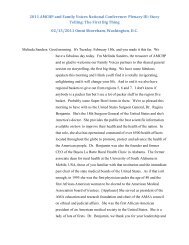



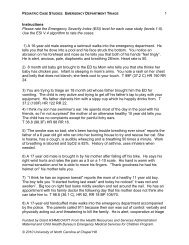
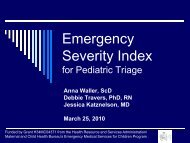
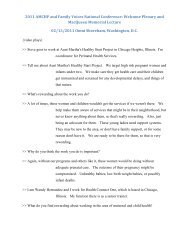
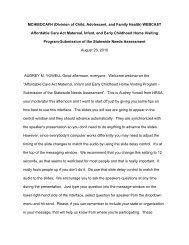
![Hormone Disruptors and Women's Health: Reasons for Concern [PDF]](https://img.yumpu.com/19410002/1/190x245/hormone-disruptors-and-womens-health-reasons-for-concern-pdf.jpg?quality=85)

